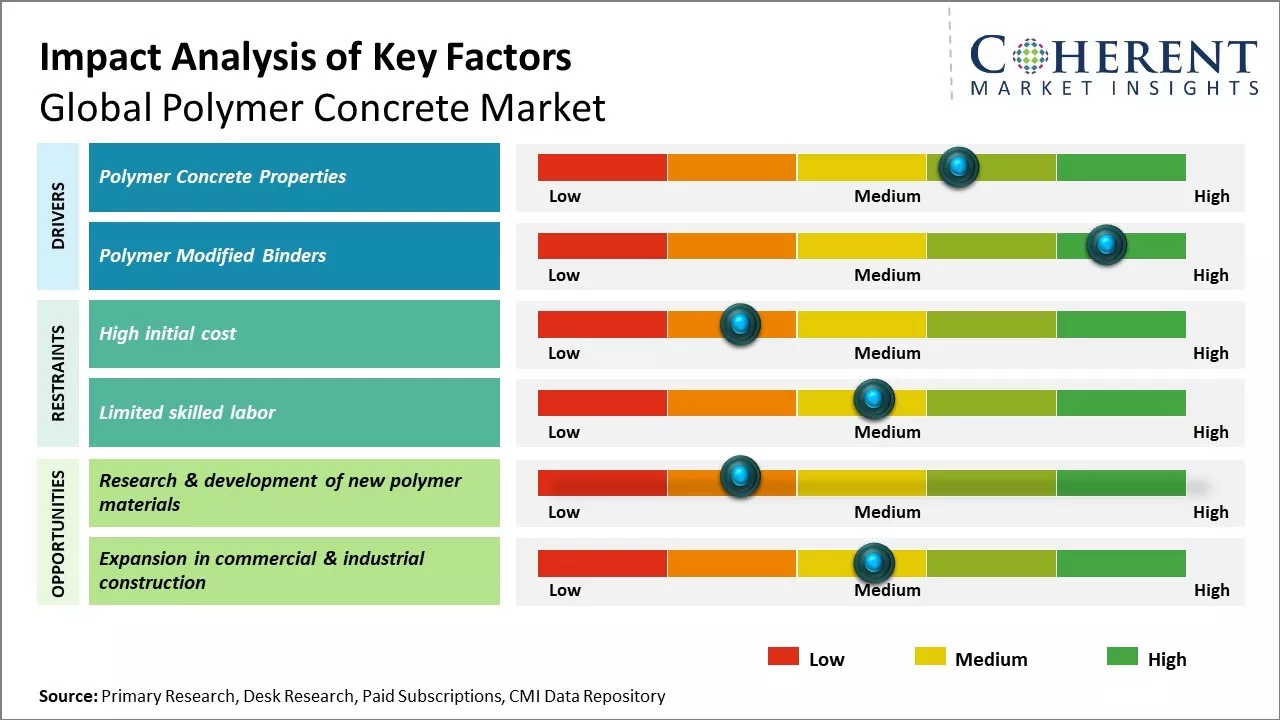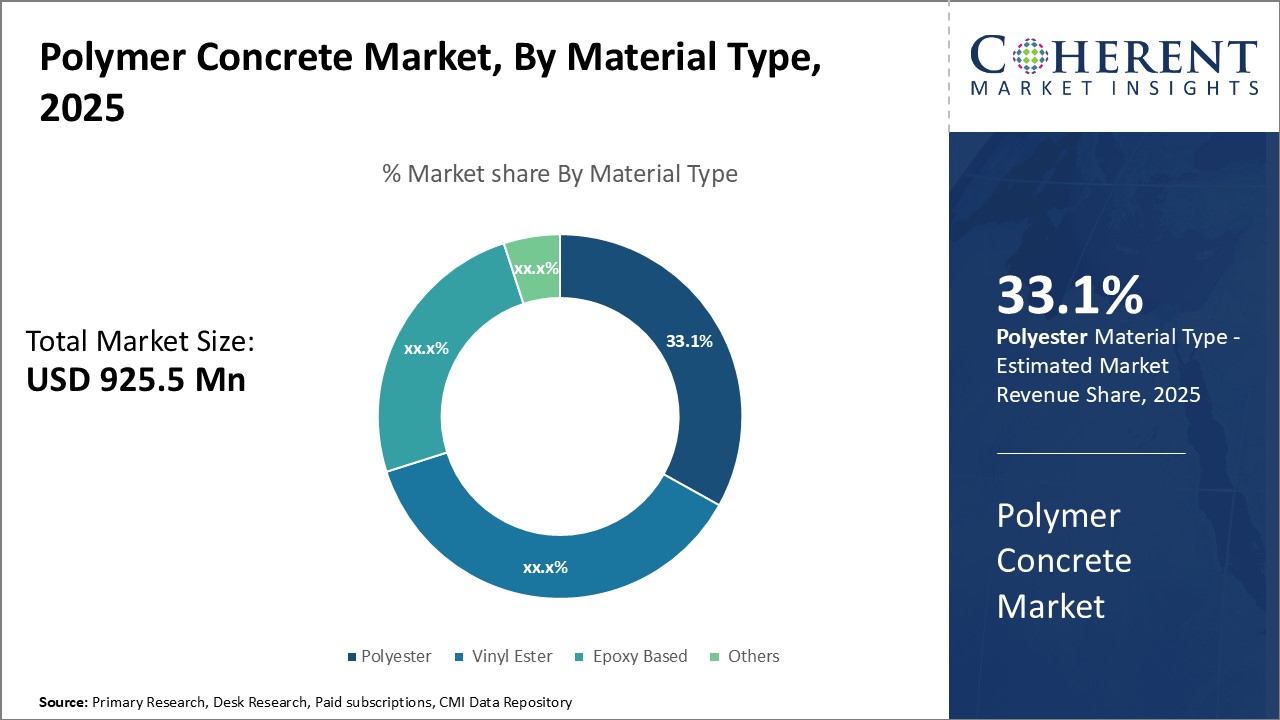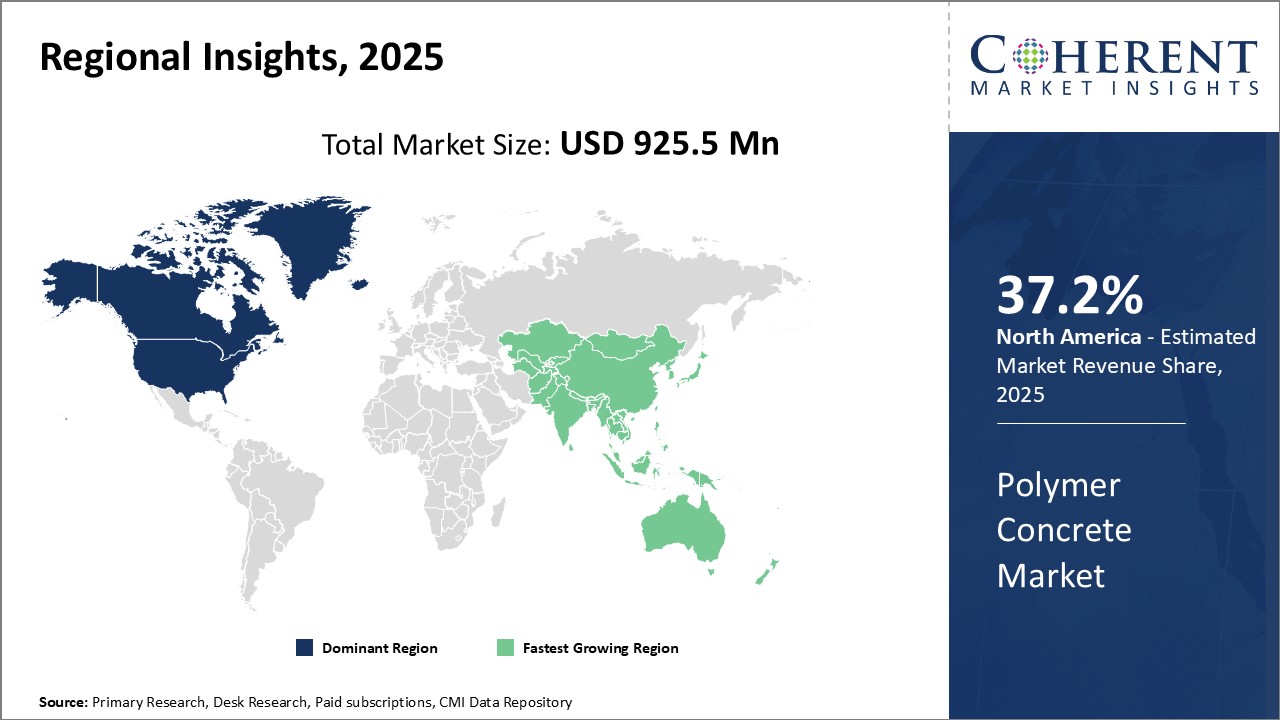The polymer concrete market is estimated to be valued at USD 925.5 Mn in 2025 and is expected to reach USD 1,577.0 Mn by 2032, growing at a compound annual growth rate (CAGR) of 7.9% from 2025 to 2032.

Discover market dynamics shaping the industry: Download Free Sample
The growing construction industry and increasing infrastructure development activities are expected to boost the demand for polymer concrete worldwide. Polymer concrete offers various advantages over traditional concrete such as high strength, corrosion resistance, chemical resistance, and faster curing time. Its ability to withstand harsh weather conditions and environments make it suitable for applications in waste containment areas, industrial plants, and marine structures. Additionally, growing repair and rehabilitation activities of old structures is further expected to drive the polymer concrete market growth during the forecast period.
Polymer Concrete Properties
Polymer concrete has superior properties that make it suitable for various applications where durability is required. It can withstand harsh environmental conditions better than ordinary concrete. The polymer components added to concrete help in improving some critical properties. The molecular structure of the polymer binds well with the cement sand mix and fills all the voids, thereby making the final product highly dense and impermeable. This dense nature disallows the penetration of water, chlorides, chemicals, and other corrosive materials. It is resistant to cracking even if subjected to extreme temperature variations and weathering. These unique properties ensure the longevity of structures and reduction in maintenance costs. The enhanced strength and resistance to weathering make polymer concrete an excellent option for applications in the construction industry, maritime structures, sewage, and wastewater systems.

Get actionable strategies to beat competition: Download Free Sample
Polymer Modified BindersAnother major factor supporting the demand is the development and availability of innovative polymer modified binders. Concrete technology is continuously evolving with new product development. Researchers are formulating novel polymer emulsions and binders that can amalgamate well with cement concrete. These modern binders enhance the workability and finish of concrete along with improving long-term mechanical qualities. Epoxy, MMA, and polyester based binders have gained wide acceptance. Their application leads to concrete mixtures exhibiting advanced physical and chemical properties compared to normal concrete. The binders fill voids, densify the concrete network structure and impart corrosion, chemical, and abrasion resistance. This has spurred the use of polymer concrete in new application areas where durability and strength are major prerequisites. Manufacturers are integrating these advanced binders in their product portfolios to cater to emerging requirements from end-use industries.
Key Takeaways of Analyst:
The polymer concrete market is expected to grow steadily over the forecast period. Key drivers for growth include increasing construction of industrial floors that require high chemical and mechanical resistance. Additionally, rising investments in infrastructure projects globally will boost demand. However, high raw material prices, particularly of polymers, may restrain market growth to some extent.
The market also presents opportunities for players as polymer concrete finds increasing acceptance as an alternative to traditional construction materials. Infrastructure renewal programs in developed economies provide a fertile ground for sales expansion.
The Asia Pacific region, led by China and India, will likely dominate market volume share owing to gigantic government spending on road and building construction projects. North America will remain an important revenue generator as repair and rehabilitation of aging infrastructure gathers steam in the U.S. and Canada.
Challenges: High initial cost
One of the major factors hindering the growth of the global polymer concrete market is the high initial capital cost associated with it. Polymer concrete requires specialized equipment and materials for production which makes the initial investment quite high. The raw materials used such as resins, hardeners, and aggregates are quite expensive compared to conventional concrete. Moreover, the machinery used for mixing, casting and curing of polymer concrete slab also has a significant price tag which includes mixers, moulds, compressors, ovens etc. This high upfront expenditure prohibits many small and mid-sized construction projects from adopting polymer concrete.
Opportunities: Research & development of new polymer materials
Research and development of advanced polymer materials holds tremendous potential to drive innovation and growth in the global polymer concrete market. Polymers offer properties like flexibility, strength and durability that can help address many of the shortcomings of traditional concrete. Ongoing material science breakthroughs are leading to the discovery and commercialization of novel polymers with unique performance characteristics. For example, polyurethane and epoxy based formulations are being developed that provide greatly enhanced chemical resistance, abrasion resistance, and impermeability compared to traditional materials. These new polymers could enable polymer concrete to competitively penetrate demanding application areas like wastewater infrastructure that currently rely on more expensive alternatives.

Discover high revenue pocket segments and roadmap to it: Download Free Sample
Insights by Material Type: The robust properties of polyester drive its market dominanceIn terms of material type, polyester is expected to contribute 33.1% share of the market in 2025, owing to its robust mechanical and chemical properties. Polyester polymer concrete is highly durable and resistant to chemicals, making it well-suited for applications that face harsh environmental conditions. Its high bond strength allows it to withstand stresses and impacts without breaking or cracking. Polyester concrete's mechanical strength comes from the molecule-level crosslinking bonds formed during curing between its polyester resin and aggregate fillers. This crosslinking polymerization process results in a tightly bonded, inflexible solid matrix structure that is highly dimensionally stable. It does not deform or swell when exposed to water, oils, de-icing salts, or other corrosive substances that can degrade lesser materials. The rigid polyester matrix also conveys excellent abrasion and wear resistance to polyester concrete. Frictional forces and impulsive loads have difficulty degrading its surface, keeping it smooth and protective for long-term use. Applications requiring resistance to foot traffic, vehicular movement or fluid contact widely utilize polyester concrete for its durable physical properties. Overall, polyester concrete delivers class-leading mechanical integrity from a tough, impermeable solid structure. Its chemical inertness and dimensional stability further enhances its ability to withstand real-world stresses and exposures. This resilience has made polyester the preferred material type where long-lasting performance is essential.
Insights by Binding Agent: Synthetic resins lend design flexibility to polymer concrete applications
In terms of binding agent, synthetic resin is expected to contribute 34.1% share of the market in 2025, due to its ability to be custom-formulated for specific job requirements. While natural resins from plant and mineral sources can bind polymer concrete aggregates, synthetic resins offer greater design flexibility through precise molecular engineering of their properties. By altering resin components and formulations, synthetic binders allow polymer concrete properties like strength, flexibility, toxicity, and curing speed to be tailored as needed. Complex blended resins with desired performance attributes can be consistently manufactured for various application parameters. Resin engineers are continually developing advanced binders with improved characteristics like faster setting, higher heat tolerance, or lower permeability. Synthetic resin binders also provide consistency from batch to batch that natural resins cannot always match. Strict quality control over monomer makeup and production yields uniformly performing polymer concrete. Field installers and end users gain reliability knowing the material characteristics. As construction and infrastructure projects grow in technical complexity, synthetic binders prove invaluable in creating customized polymer concretes. Specialized resin formulations open new implementation possibilities by overcoming job challenges natural resins could not.
Insights by Application: Polymer concrete supports complex solid surface applications
In terms of application, flooring blocks is expected to contribute 36% share of the market in 2025, owing to the advanced solid surface capabilities of polymer concrete. Its molecular-level composition allows it to be poured, molded, or machined into intricate, seamless designs unattainable with traditional concrete. Complex curved and angled surfaces for flooring emulate natural stone without its limitations. Monolithic flooring creates hygienic, slip-resistant surfaces ideal for food processing plants, dairies, locker rooms, and other wet industrial environments. Antimicrobial polymer concrete resists mold and bacterial growth. Its non-porous nature eliminates absorption of contaminants and odors for easier cleaning. Functionally, polymer concrete floors deliver rigidity under heavy rolling loads along with resilience to cushion falling impacts. Vehicular traffic areas in garages and loading docks benefit from its strength and abrasion resistance. Outdoor sports floors withstand weathering while indoor versions offer acoustical sound dampening. As a engineered material, flooring producers manipulate polymer concrete’s physical properties for LEED high-performance building credit. Low-VOC formulations with recycled content promote sustainable construction practices. Design abilities also create aesthetic flooring resembling expensive natural stone at lower costs and maintenance requirements. Overall, polymer concrete overcomes limitations of basic flooring media through its molecular engineering and moldability into seamless, durable solid surfaces. This drives the material’s widespread use in flooring applications above other market segments.

Need a Different Region or Segment? Download Free Sample
North America has been dominating the global polymer concrete market with 37.2% of the market share in 2025 owing to a strong presence of major polymer concrete manufacturers and users in the region. The U.S. is home to some of the largest polymer concrete companies in the world including Sika Corporation and Fosroc which have been investing heavily in R&D to develop advanced polymer concrete materials. The region also has stringent government regulations regarding the use of materials that provide durability and sustainability for infrastructure projects. This has significantly boosted the demand for polymer concrete from the transportation and construction industries. Moreover, North America is an early adopter of new technologies and materials. Established application areas such as containment structures for wastewater treatment have also contributed to North America's leading position.
Asia Pacific has emerged as the fastest growing regional market for polymer concrete in recent years. The growth can be attributed to expanding construction activities and rapid industrialization taking place across developing countries of the region. Countries like India and China have been investing heavily in building roads, bridges, buildings, and other infrastructure on a large scale. This has opened up opportunities for advanced building materials like polymer concrete. Additionally, strong export orientations of the Asia Pacific economy have also augmented the usage of polymer concrete in manufacturing applications involving chemical containment and processing plants. Local polymer concrete producers such as BASF India have established themselves well by providing cost effective solutions. The Asia Pacific market is expected to witness continued growth due to rising expenditures on public infrastructure projects and growing industrial sectors in the coming years.
Polymer Concrete Market Report Coverage
| Report Coverage | Details | ||
|---|---|---|---|
| Base Year: | 2024 | Market Size in 2025: | USD 925.5 Mn |
| Historical Data for: | 2020 To 2024 | Forecast Period: | 2025 To 2032 |
| Forecast Period 2025 to 2032 CAGR: | 7.9% | 2032 Value Projection: | USD 1,577.0 Mn |
| Geographies covered: |
|
||
| Segments covered: |
|
||
| Companies covered: |
BASF SE, Sika AG, Wacker Chemie AG, Dudick Inc., ACO Group, Kwik Bond Polymers LLC, Sauereisen Inc., Hubbell Power Systems Inc., Forte Composites, Inc., Ulma - Architectural Solutions, Sandmix., CUMI Prodorite & Composite, Mcon Rasayan Pvt. Ltd., and Romtec Utilities |
||
| Growth Drivers: |
|
||
| Restraints & Challenges: |
|
||
Uncover macros and micros vetted on 75+ parameters: Get instant access to report
*Definition: The polymer concrete market comprises materials made by binding aggregates and other fillers with a polymeric compound to form concrete-like building materials that are used in applications requiring chemical resistance, abrasion resistance, durability, and high strength. Polymer concrete consists of aggregates such as sand, gravel, or crushed stone that are bound together with a polymer resin. It offers greater resistance to solvents, acids, chemicals, and fire compared to traditional concrete.
Share
Share
About Author
Vidyesh Swar is a seasoned Consultant with a diverse background in market research and business consulting. With over 6 years of experience, Vidyesh has established a strong reputation for his proficiency in market estimations, supplier landscape analysis, and market share assessments for tailored research solution. Using his deep industry knowledge and analytical skills, he provides valuable insights and strategic recommendations, enabling clients to make informed decisions and navigate complex business landscapes.
Missing comfort of reading report in your local language? Find your preferred language :
Transform your Strategy with Exclusive Trending Reports :
Frequently Asked Questions
Joining thousands of companies around the world committed to making the Excellent Business Solutions.
View All Our Clients